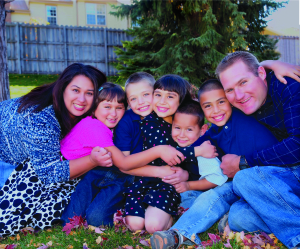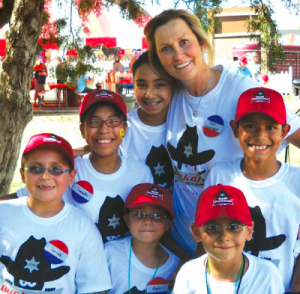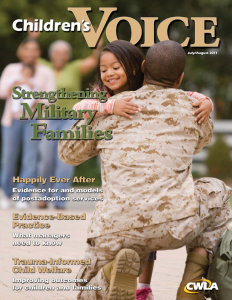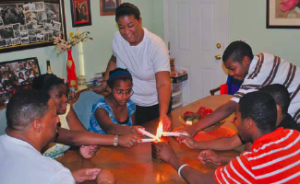Featured Article: Evidence for and models of postadoption services to help families succeed

The Colorado Post-Adoption Resources Center, a public-private partnership, includes a day for adoptive families to get a family portrait free of charge. Photo Courtesy of Lisa Tokpa/Coparc
Each and every time, it’s a meaningful and emotional moment–there are probably hugs, maybe tears, some handshakes and clapping–and then a family becomes official. But what happens next?
It depends, of course, on the new family and how truly prepared they were by the cast of characters that populated the story up to this point. Friends and extended family, naturally, but also recruiters, counselors, trainers, caseworkers, a permanency specialist or two, maybe a few lawyers and a judge–the list can get pretty long. The prelude leading up to an adoption has been critically important for the family-to-be, but it’s all been building up to this next chapter: their life together.
The Need for Services
Postadoption services can influence whether the adoption has a happy ending, with the promise of a “forever family” fulfilled, or whether there are struggles adjusting to life together that may lead to a disruption. A varying array of postadoption services are available in all states; many private agencies partner with or supplement public state offerings. (See Question 7 of the Child Welfare Information Gateway’s “Adoption Assistance by State” database atwww.childwelfare.gov/adoption/adopt_assistance for specific state details.) But postadoption services, perhaps because they come once finalization is over, are often an afterthought. Even when these services are available and explained, generally families don’t pick up the phone or visit the office until they’re in a real crisis.
From Capitol Hill
“In June, postadoption services got attention from Con-gress. The U.S. House of Representatives Committee on Ways and Means, Subcommittee on Human Resources, held a hearing on reauthorization of Title IV-B of the Social Security Act. Comprised mainly of two parts, Title IV-B provides more than $700 million in both mandatory and discretionary annual funding for states, tribes, and territories. The funding is used to provide maltreatment prevention, family strengthening, and intervention services to all children and their families. Within Title IV-B is the Promoting Safe and Stable Families (PSSF) program, which funds four types of services for families in need in different ways. For adoptive families, this means both pre- and postadoption services. The Colorado Post-Adoption Resources Center is funded through PSSF.
The Evan B. Donaldson Adoption Institute Executive Director Adam Pertman and Program Director Susan Livingston Smith submitted written testimony for the hearing and focused on PSSF. Specifically, the Institute recommended that a dedicated funding stream for postadoption services be created by redefining the service category of “adoption promotion and support” in PSSF to become “adoption and postadoption services,” and by requiring that a portion of these funds be expended on postadoption services. The Institute’s full testimony is available atwww.adoptioninstitute.org/policy/advocacy.php.
CWLA also submitted testimony for the hearing; it addressed PSSF, but discussed Title IV-B more generally. Visit the Title IV-B section on cwla.wpengine.com/advocacy/statements.htm to download or read CWLA’s testimony. For an account of the hearing and more links, read the June 17 Children’s Monitor report at childrensmonitor.wordpress.com.”
People think asking for help is a sign of weakness, says Adam Pertman, executive director of the Evan B. Donaldson Adoption Institute. Parents may feel like once the state has placed a child with them and agreed to an adoption, they should be able to handle whatever happens on their own. This is simply the wrong attitude, Pertman says: “We have to explain that asking for help is a strength.”
Getting that message across, he says, is one goal of a much broader seismic shift in child welfare. Pertman recently presented a webinar for CWLA and called it “Rethinking Adopt-ion,” pithily summarizing his agenda. He argues that success should join the trio of factors child welfare workers usually use to judge outcomes: safety, permanency, and well-being.
Child placements are up, and more than two-thirds of non-stepparent adoptions in the United States feature children and youth from the child welfare system, he noted in the webinar. This is mostly positive, but it’s important to understand that children who have spent time in the child welfare system were there because they experienced abuse or neglect. They’ve virtually all suffered significant psychological trauma, even if many of them do not translate that into negative behavior. “We’re getting pretty good at placing children in homes,” Pertman says. “The problem is, there are too many families who are safe, loving, permanent… and are not successful. Some of them are struggling mightily every day.”
To help them, Pertman knows it’s necessary to start at the beginning. “We’re really talking about a continuum of services,” he says, “that starts preadoption and continues for as long as necessary.” This isn’t a new concept. CWLA’s well-known training model, Parent Resources for Infor-mation, Development, and Education (PRIDE), operates on a continuum that starts even before workers begin recruitment of foster or adoptive families. What might be new, however, is the focus on postadoption services as a way to strengthen and ensure permanency–and the reason such a focus is becoming increasingly necessary.
First, Pertman emphasizes, it’s important to understand that the majority of adoptive families are doing fine. In the National Survey of Adoptive Parents, only 15% reported their relationships with their children are “more difficult” than they had expected. On average, the same percentage of children ages 6 to 18 adopted from the child welfare system will show severe behavioral problems and significant attachment issues. But this minority makes the news when the families do come apart. Take, for example, last year’s story about a Tennessee mother who had adopted a boy from Russia, but put him on a plane back to Moscow alone, apparently unable to cope with his alleged violence and psychological challenges. In a statement at the time, CWLA CEO Christine James-Brown said the incident “furthers our resolve that adoptive parents need preadoptive training and postadoption services. These are crucial elements to successful adoptions.”
In the same vein, CWLA joined several other organizations in endorsing the findings and recommendations of a report the Adoption Institute published last fall, Keeping the Promise: The Critical Need for Post-Adoption Services to Enable Children and Families to Succeed. The report examines the array of service needs for adoptive families and makes recommendations for how to move forward. “This is the field talking,” Pertman asserts. “This is the field saying, ‘enough is enough… the time has come.'”

The Buckaroo Stampede is one of COPARC’s annual events for adoptive families. Photo Courtesy Lisa Tokpa/Coparc
Providing Services
Despite the headlines, Tennessee actually has very good postadoption services available, Pert-man noted in his recent webinar. In the last year the state has opened their services to families who have finalized private domestic and international adoptions, in addition to those adopting from the child welfare system, for whom the services were first envisioned. Families adopting from foster care are entitled to the services free of charge; families adopting outside the public system pay based on a sliding scale. The Department of Children’s Services (DCS), a CWLA member agency, contracts with Harmony Adoptions–who helped fund the Adoption Institute’s Keeping the Promise report–to provide postadoption services to child welfare adoptive families. Agape Child and Family Services and Catholic Charities of Tennessee help with other adoptive families.
John L. Johnson, director of foster care and adoptions at Tennessee DCS, notes that their quality postadoption services, known as Adoption Support and Preservation (ASAP), have led to a dissolution rate of only 2%. “We feel very confident that when we are brought to the table with these families that there’s a nice level of success and giving them what they need,” he says. Services are available until a youth turns 19.
“Usually there’s a legitimate concern” when parents contact DCS and open an ASAP case, Johnson continues. “We’ll definitely sit down and talk with them about the options we’ve got for service.” He says the “menu” includes 20 different services, including trainings and therapies.
Pertman’s comments about families being reluctant to seek help resonate with Johnson. “Families have a deep core feeling that ‘I have to be responsible,’ that ‘I’ve been entrusted with the life of this child,'” Johnson explains. Put simply, they want to be successful on their own.
As soon as a letter of intent to adopt is signed with a family, they are given information about ASAP as well as preparatory preadoptive training. “We often recognize those families who can most benefit from it,” Johnson says. He thinks the age of the child is a strong indicator of when a little extra help might be useful. “Small children have the most resiliency I have ever seen,” he says. “Generally children up into 3 and 4 years old, even at a moderate level of trauma, do not have any ongoing issues or problems.” However, most of the foster care population in Tennessee is at least a decade older than that, and it makes Johnson nervous. “Looking at our population, over 65% of them are teenagers. Those teenagers have a different level of experience,” he says, which includes not only abuse or neglect, but usually multiple placements on top of the regular upheaval of adolescence. They face what Johnson calls “a compounding of issues,” and so adjusting into an adoptive family can be more difficult. Walking the line between encouraging prospective adoptive parents to take advantage of services and frightening them away from adopting can be a challenge, he explains.
But Johnson thinks the structure in Tennessee sets up multiple opportunities to help families. In addition to a family service worker (case manager), a permanency specialist will have a good idea of what services are available in a particular area. DCS has at least one permanency specialist in each of the state’s 12 geographic regions. Then, for families who qualify for adoption subsidies, subsidy staff will ask the families if they want more information on ASAP. That means, according to Johnson, “three different staff members will have three different conversations with you” about postadoption services.
Johnson’s advice for other states? “Give yourself a feedback loop,” he says. He’s taking his own advice, as Tennessee is in the middle of a survey of adoptive families to assess, as he puts it, “Are we doing as well as we perceive that we are?” DCS must get messages across to families, but an equally important part of the job is being receptive to messages coming in. “Listen to what families tell you,” he says, confident that DCS clients will help the agency improve in turn. “The families will tell us what we need to do.”
In Colorado, there is also a public-private partnership for providing postadoption services, and the program there has some similarities with Tennessee, but some marked differences as well. The Colorado Post-Adoption Resources Center (COPARC) is a partnership between The Adoption Exchange and the Colorado Department of Human Services, both CWLA member agencies. While both agencies separately offer other services, at its core COPARC strives to disseminate information and spread knowledge. While Lisa Tokpa, project director, confirms that staff do work to let families know what COPARC offers, it’s more of a self-service and by-request model than others.
‘Keeping the Promise’
Excerpts from some of the key recommendations from the Evan B. Donaldson Adoption Institute’s report, available in full from www.adoptioninstitute.org/research/2010_10_ promises.php.
-
Create a national task force to provide strategic planning and legislative leadership for the development of postadoption services–composed of representatives from the U.S. Children’s Bureau and the U.S. Department of State, as well as postadoption experts, practitioners, and researchers.
-
Develop private and public funding partnerships to maximize services and access to them for families, including a dedicated federal funding stream for postadoption services.
-
Public policy and child welfare officials at every level–federal, state, county, and local–should reexamine their current budgets, staffing, and other resources to determine whether sufficient priority is being given to helping families succeed as well as forming them.
-
The amount of funded research on postadoption interventions should be increased significantly in order to create an evidence base on services that are most effective, and the resulting findings and information must be systematically disseminated to adoption practitioners.
-
University, graduate, and continuing education curricula on adoption issues need to be created for and provided to the professionals who work with adopted children and their families.
Additional recommendations, as guidance for professionals and policymakers, include:
-
Minimize damage to children in the child welfare system and elsewhere. Providing sensitive nurturance after separation from birth families, minimizing moves in care, finding the right home as early as possible, and giving support through transitions are all aspects of this goal.
-
Prepare parents to expect some ongoing challenges and to understand the benefits of postadoption services. Parents need help to understand the specific children they adopt, including the needs they may have because of the personal histories they bring with them.
-
Identify children at high risk of developing later difficulties and provide their families with early intervention services and linkage with ongoing resources. Supports for these families are essential to help them gain a firm foundation and optimize their prospects for success.
-
Halt reductions in subsidies and postadoption services, and raise them wherever possible by realigning priorities. Such cutbacks only serve to discourage families from adopting, resulting in greater expenses for foster care and higher costs to the state in other areas.
-
End state policies that effectively force adoptive parents to relinquish their children to the child welfare system in order to receive services they need. Everyone’s interests are better served when these children and youth are permitted to get services, such as residential treatment, while remaining as members of their families.
Like ASAP, COPARC counts its primary audience as adoptive families with children from foster care, but families who have adopted privately in the state or from other countries can pay for services. COPARC offers classes on issues such as attachment, grief and loss, and transracial adoption; it also has newsletters, guides, lending libraries, and webpages with adoption-related listings. A handful of classes are held throughout the state during the year, taught by staff members or contracted professionals. The topics are chosen based on the need in the community. Many classes are geared toward child welfare, mental health, or education professionals. “All of our classes are open to adoptive parents, even if it’s targeted toward social workers or child welfare supervisors,” Dixie van de Flier Davis, executive director of The Adoption Exchange, points out. “Both the parents and the professionals learn more when they are co-trained.”
This emphasis on mutual learning and on the local community is clear and purposeful; COPARC wants communities to support adoptive families just as much as it wants families to support themselves. “Our belief is that the well-being of families is only going to happen when their communities are dedicated to supporting them,” Tokpa says. “We put a lot of emphasis on community awareness and community education. Our networks with counties, with faith-based organizations, all play into creating supportive communities.” It’s an approach that echoes one of Pertman’s messages in the webinar–that the number of people affected by adoption is far, far greater than adoptees and their immediate families. He believes that part of rethinking adoption is bringing it into focus in mainstream parenting discussions, no longer consigning it to a niche position. “We are not part of the niche, what we do affects a lot of people,” he said. “When you add it all up, we have to rethink it because the number of people affected or who affect those children and their families is most of the country.”
A frequent request COPARC fields is for more training so people can become respite care providers. It’s crucial, Tokpa and Davis both note, for parents to have access to quality respite care from providers who can appreciate the special histories and unique challenges their children have. It’s much more specialized than the routine care a typical babysitter or day care provider might give. “Respite is a break, it’s a needed break,” Tokpa says, when an adoptive parent takes “intentional time to regroup and refresh themselves so that they can be a better parent when they return.”
“Often we don’t hear from families until they’re in crisis and they need us,” Tokpa admits. Like Johnson and Pertman, Davis adds this depends on the families: some new adoptive families are in a “honeymoon period” and some people “are loath to seek help,” she says. Gentle reminders in newsletters and outreach phone calls from The Adoption Exchange have done a lot to encourage adoptive families to keep up the relationship, and that can lead them back to COPARC. Plus, there are perks: in Colorado, one Saturday a year a professional photographer is booked for a full day and takes adoptive family portraits, gratis for the families. In Tennessee, ASAP recently added equine therapy, which may be an opportunity that entices more participation in postadoption services.
Davis gives advice similar to Johnson: “Listen to your adoptive parents–they know what they need,” she says. And she wants her fellow private agency leaders to take advantage of partnerships: “Each of us has our own unique thing that we can bring to this; it’s only effective when we all work together.”
Meghan Williams is a Contributing Editor to Children’s Voice.
Contact Colorado
Learn more about the Colorado Post-Adoption Resource Center online at https://bit.ly/coparc. Contact Lisa Tokpa, project director, at ltokpa@adoptex.org or 303-755-4756, ext. 222.
Contact Tennessee
Learn more about the Adoption Support and Preservation program online at www.tnasap.org. Contact John Johnson, director of foster care and adoption, at john.johnson@tn.gov or 615-253-6351
Purchase this Issue

Other Featured Articles in this Issue
Happily Ever After
Evidence for and models of postadoption services to help families succeed
Ensuring Military Families Are the Best They Can Be
Strengthening families to prevent child abuse and neglect
Moving Toward Trauma-Informed Child Welfare
Examples from the field
The Benefits and Risks of Evidence-Based Practice in Child Welfare
How should research impact your agency’s work
Departments
• On the Road with FMC
A child-driven, child-first future
• Leadership Lens
• Spotlight On
• National Newswire
• Down to Earth Dad
Full fatherhood goals
• Working with PRIDE
Penny Lane Centers: Passion and commitment
• CWLA Short Takes
• End Notes
• One On One
An interview with Joseph Costa, CWLA Board Chair

